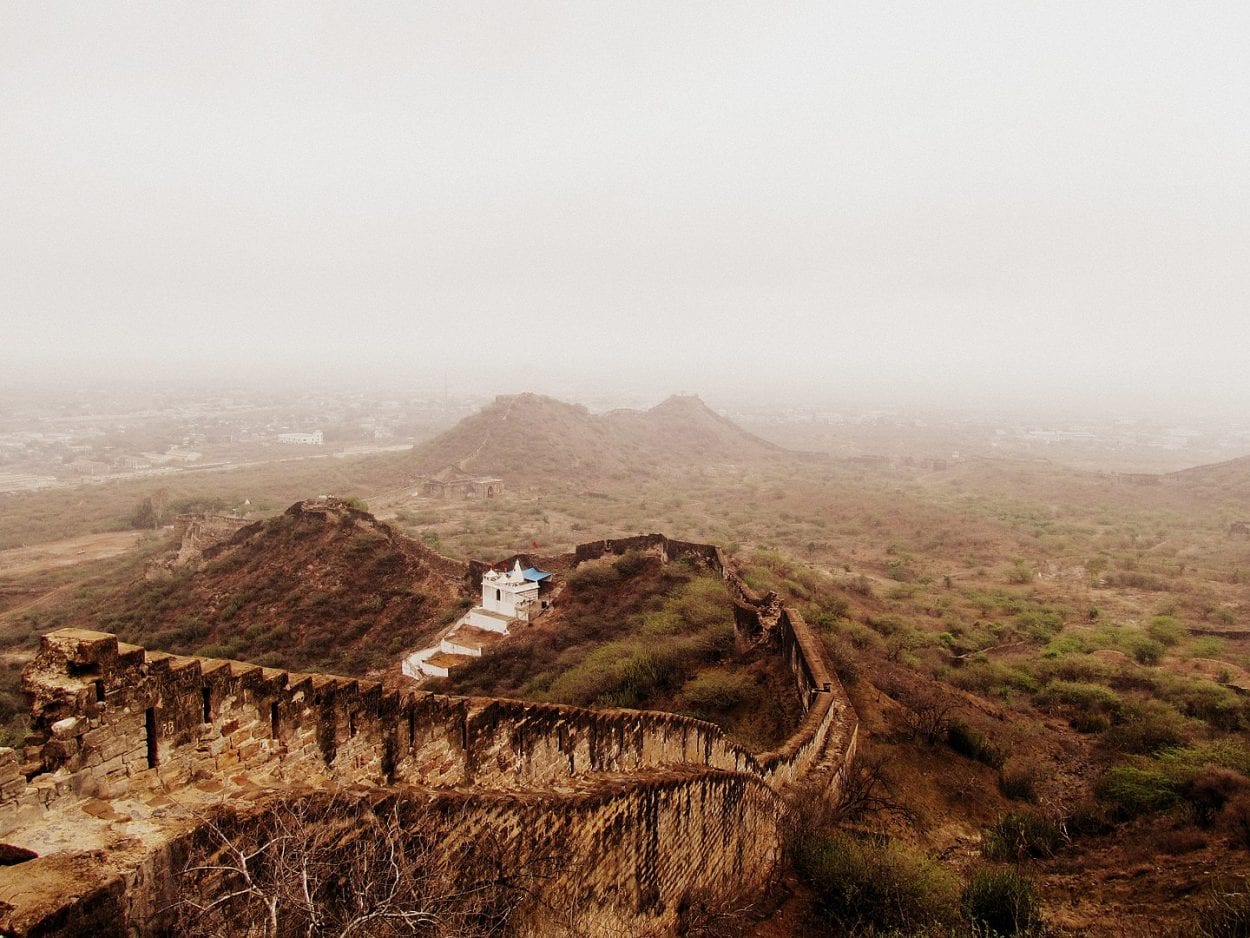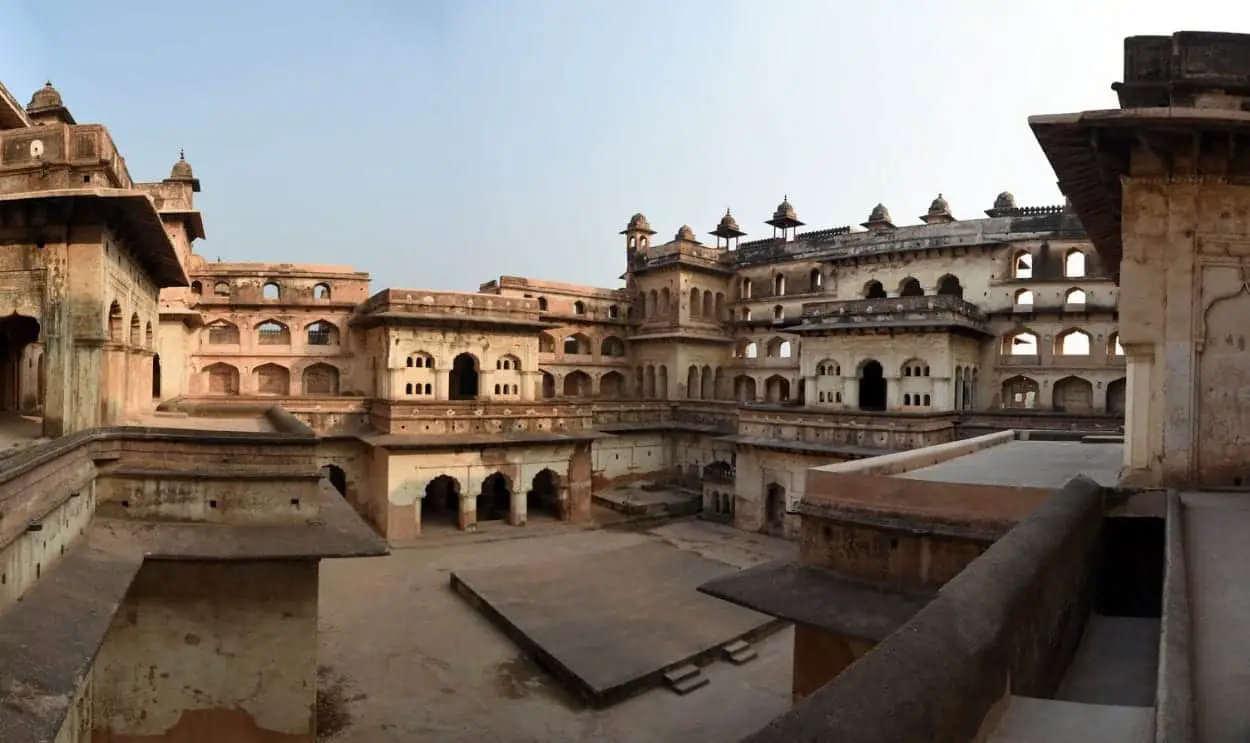Most of the forts in India are actually castles, fortified palaces or fortresses, but when the British Government in India were cataloguing the defences in the 17th–19th century, they used the word forts which became the common description across India.
In local languages the fort names are suffixed by local word for fort thus usage of the Sanskrit word durga, or Hindi word qila or the word garh or gad in Rajasthan, Assam and Maharashtra is common.
The capital of each raja or chieftain was a fort around which a township grew and developed; this pattern can be seen in many South Asian cities such as Delhi, Agra, Rajasthan, Lahore, Pune, Kolkata, Surat and Mumbai.
1 – Mehrangarh Fort
Mehrangarh Fort, located in Jodhpur, Rajasthan, is one of the largest forts in India. It is believed to have been Built around 1460 by Rao Jodha, the chief of the Rathore clan. The fort is situated 410 feet (125 m) above the city and is enclosed by imposing thick walls. Inside its boundaries there are several palaces known for their intricate carvings and expansive courtyards that include the Moti Mahal (Pearl Palace), Phool Mahal (Flower Palace), Sheesha Mahal (Mirror Palace), Sileh Khana and Daulat Khana.

2 – Red Fort
The Red Fort is a historical fort in the city of Delhi in India, constructed in 1639 by the fifth Mughal Emperor Shah Jahan as the palace of his fortified capital Shahjahanabad and is named for its massive enclosing walls of red sandstone. It was the main residence of the emperors of the Mughal dynasty for nearly 200 years, until 1857. The imperial apartments consist of a row of pavilions, connected by a water channel known as the Stream of Paradise (Nahr-i-Bihisht). The fort complex is considered to represent the zenith of Mughal creativity under Shah Jahan, and although the palace was planned according to Islamic prototypes, each pavilion contains architectural elements typical of Mughal buildings that reflect a fusion of Timurid and Persian traditions.

3 – Bhujia Fort
Bhujia Fort (Bhujiya Fort) is a fortress located in the outskirts of the town of Bhuj in the district of Kutch, Gujarat built on Bhujia Hill. Construction of Bhujia fort was started by Rao Godji I (1715–1718) ruler of Kingdom of Kutch as a sort of outwork defence for Bhuj. However, the major work and completion was done during the rule of his son, Deshalji I (1718–1741). The Fort has seen six major battles since its construction, most of which were fought in the years 1700-1800 AD between the Rajput rulers of Kutch and Muslim raiders from Sindh and the Mughal rulers of Gujarat.

4 – Gwalior Fort
Gwalior Fort is an 8th-century hill fort near Gwalior, Madhya Pradesh, central India. The fort consists of a defensive structure and two main palaces, Gujari Mahal and Man Mandir, built by Man Singh Tomar. The fort has been controlled by a number of different rulers in its history. The Gujari Mahal palace was built for Queen Mrignayani and is now an archaeological museum. The oldest record of “zero” in the world was found in a small temple, which is located on the way to the top. The inscription is around 1500 years old.

5 – Mudgal
Mudgal is a panchayat town in Lingsugur taluk, Raichur district in the Indian state of Karnataka. In the construction of the fort at Mudgal, advantage was taken of a hillock on the top of which were built houses of the royalty and a wall with bastions. The outer fortifications of Mudgal cover an area of half a square mile.

6 – Bidar Fort
Bidar Fort is situated in Bidar city of the northern plateau of Karnataka, India. The fort, the city and the district are all affixed with the name Bidar. Sultan Alla-Ud Din Bahman of the Bahmanid Dynasty shifted his capital from Gulbarga to Bidar in 1427 and built his fort along with a number of Islamic monuments. Constructed on the edge of a plateau, Bidar fort has a haphazard rhombus-shaped layout.

7 – Chittor Fort
The Chittor Fort or Chittorgarh is one of the largest forts in India. It is a World Heritage Site. The fort was the capital of Mewar and is today situated in the Chittorgarh town. It sprawls over a hill 180 m (590.6 ft) in height spread over an area of 280 ha (691.9 acres) above the plains of the valley drained by the Berach River. The fort precinct has several historical palaces, gates, temples and two prominent commemoration towers. These monumental ruins have inspired the imagination of tourists and writers for centuries.

8 – Orchha Fort
The Orchha Fort complex, which houses a large number of ancient monuments consisting of the fort, palaces, temple and other edifices, is located in the Orchha town in the Indian state of Madhya Pradesh. The fort was built following the founding of the Orchha State in 1501 AD by Rudra Pratap Singh (r. 1501–1531), a Bundela rajput. The palaces and temples within the fort complex were built over a period of time by successive Maharajas of the Orchha State.

9 – Lohagad
Lohagad is one of the many hill forts of Maharashtra state in India. Situated close to the hill station Lonavala and 52 km (32 mi) northwest of Pune, Lohagad rises to an elevation of 1,033 m (3,389 ft) above sea level. The fort is connected to the neighboring Visapur fort by a small range. The fort was under the Maratha empire for the majority of time, with a short period of 5 years under the Mughal empire.

10 – Amer Fort
Amer Fort is located in Amer, Rajasthan, India. The fort is originally believed to have been built by Raja Man Singh during 967 AD. The structure was fully expanded by his descendant, Jai Singh I. Even later, Amer Fort underwent improvements and additions by successive rulers over the next 150 years, until the Kachwahas shifted their capital to Jaipur during the time of Sawai Jai Singh II, in 1727.

11 – Golkonda
Golkonda, also known as Golconda, Gol konda (“Round shaped hill”), or Golla konda, is a citadel and fort in Southern India and was the capital of the medieval sultanate of the Qutb Shahi dynasty (c.1518–1687), is situated 11 kilometres (6.8 mi) west of Hyderabad. Golkonda Fort was first built by the Kakatiya dynasty as part of their western defenses along the lines of the Kondapalli Fort. The city and the fortress were built on a granite hill that is 120 meters (480 ft) high, surrounded by massive battlements.

12 – Agra Fort
Agra Fort is located in the city of Agra and was the main residence of the emperors of the Mughal Dynasty till 1638, when Mughal capital was shifted from Agra to Red Fort in Delhi. The 380,000-square-metre (94-acre) fort has a semicircular plan, its chord lies parallel to the river and its walls are seventy feet high. Double ramparts have massive circular bastions at intervals, with battlements, embrasures, machicolations and string courses.

13 – Rajgad
Rajgad is one of the forts in the Pune district of Maharashtra state in India. The fort is around 1,400 m (4,600 ft) above sea level. Formerly known as Murumdev, it was capital of the Maratha Empire during the rule of Chhatrapati Shivaji Maharaj for almost 26 years, after which he moved the capital to Raigad Fort.

14 – Jaisalmer Fort
Jaisalmer Fort is one of the largest fully preserved fortified cities in the world. It is situated in the city of Jaisalmer, in the Indian state of Rajasthan. It was built in 1156 AD by the Rajput ruler Rawal Jaisal, from whom it derives its name. The fort stands amidst the sandy expanse of the great Thar Desert, on Trikuta Hill. Before the days of the British Raj, the fortress city served as a refuge and way-station for caravans and travelers along the Silk Road.

15 – Vijaydurg Fort
Vijaydurg is the oldest fort on the Sindhudurg coast, constructed during the regime of Raja Bhoja II of the Shilahar dynasty (construction period 1193-1205) and restructured by Shivaji Maharaj. According to legend, this is one of only two Maratha forts where Shivaji personally hoisted the saffron flag. The other fort is Torna. Vijaydurg Fort was called the “Eastern Gibraltar”, as it was virtually impregnable.

Header Image Credit : Alexey Komarov – CC BY-SA 2.0







